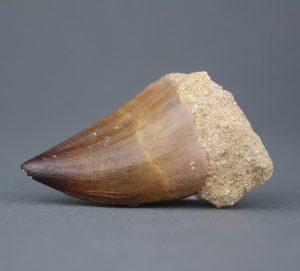Updated on: 26/03/2022
The Mosasaurus was a genus of small to monstrous sea-dwelling reptiles that lived in the waters of the Late Cretaceous oceans during the Maastrichtian geologic timescale. It included the species of mosasaurs viz. M. missouriensis, M. conodon, M. lemonnieri, and M. beaugei. These carnivores are often referred to as the ‘T-Rex of the seas’.
| Kingdom: | Animalia |
| Phylum: | Chordata |
| Class: | Reptilia |
| Order: | Squamata |
| Superfamily: | †Mosasauroidea |
| Family: | †Mosasauridae |
| Tribe: | †Mosasaurini |
| Genus: | †Mosasaurus |
| Pronunciation: | Moe-za-sore-us |
| Geological Period: | Late Cretaceous period (around 70 and 66 mya) |
| Maximum Size: | Largest specimens were 15 to 18 meters in length |
| Weight: | Around 15 tons (estimated adult mass) |
| Average Lifespan: | Unknown |
| Location/Distribution & Habitat: | In the waters between Western Europe and North America, but probably even further afield |
| Diet: | Carnivorous |
| Birth Type (Reproduction): | Oviparous (egg-laying) |
| Locomotion: | Bipedal – Quadruped |
It was back in 1764 that the mosasaur fossils were first described after they were found in a limestone quarry on the Meuse River in Holland. The ancient, enormous creature was so named since the initial remains were discovered close to the Meuse River, near the town of Maastricht in the Netherlands.
However, shreds of evidence suggest that the Native Americans from the Midwestern parts of the United States discovered the remains of this intimidating aquatic creature long before the fossils were officially described for the first time.
Eventually, after its official discovery, the scientific name Mosasaurus hoffmanni was given to honor of paleontologist Dr. C. K. Hoffman who studied the skeletal remains and presumed them to be belonging to a prehistoric giant crocodile.
The feud for owning the fossil relates a very unusual story. In 1795, it was confiscated by the French army in exchange for several cases of wine. Since then, the remains still stands inside Paris’s French National Museum.
Much later, in 1845, a German naturalist named Dr. George August Goldfuss described the creature the remains of which were unearthed from the wilds of present-day Dakota by publishing his papers.
Eventually, the specimen had been acquired by Prince Maximilian zu Wied, a German explorer, ethnologist, and naturalist, during his visit to North America. It still remains as one of the items in the Goldfuss collection of Germany’s Natural History Museum at the University of Bonn.

The body size of the species belonging to this genus could be anything between 3 and over 50 feet, which means, they were as gigantic as the megalodon. Some, like the dallasaurus, were as small as 3 feet, whereas the others, like the tylosaurus, were the largest. However, most of the mosasaurs were around 10 feet in length.
While the body was barrel-shaped ending in a strong tail, their skull was elongated, with considerably large eyes, but having poor binocular vision. Like other contemporary land reptiles, they are thought to give out roaring sounds.
By evolution, these reptiles possessed typical snake-like jaws with rows of large and sharp teeth. The jaws were double-hinged that allowed them to swallow their meals almost whole, much like the modern-day crocodilians. Because of this behavior, several specimens of unchewed prey have been discovered along with some fossil remains.
They had two pairs of reduced limbs modified into flippers, with the front pair being larger than the back, adapted for the purpose of swimming through the ocean waters.
The entire body was also covered in very dark-colored smooth scales. These creatures had to come to the surface of the water to breathe air, quite like the modern-day whales and sea turtles.
These carnivores were the apex predators in their ecosystem, attacking other marine reptiles like giant turtles, marine crocodiles, plesiosaurs, and even preying on several species of large fish including sharks, as well as ammonites and sea birds. Additionally, the larger mosasaurs would also feast upon the smaller ones.